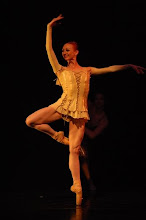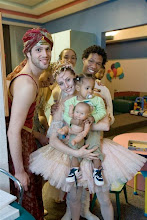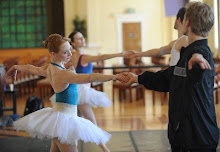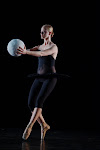He has told the story of Romeo and Juliet’s passionate and youthful love for one another, one that eliminates the separate self and expands into a new entity, an exaltation of existence beyond and bigger than who they are separately. This is, in my mind, one of the most important stories we share in our human life. We repeatedly search for something that is bigger than we are, call it God, the divine, the greater consciousness, infinite belonging, whatever you choose. When we have lost touch with it, as we inevitably do in our human fallibility and frailty, some form of deep sadness, and far too often tragedy and suffering, befall us and those around us. In the brief space of this story this is the journey we take together.
Ballet can be so beautiful. Its idealistic form and vocabulary is in almost continual consummation. Dancers and audience become one in our Romeo & Juliet, vividly present in the moment of life and death, reaching deep within to go beyond limitations. Indeed, the journey is exhilarating and often exhausting. It is not a place in time or space for people who do not want to feel the bare, the acute that puts us starkly in touch with life and death, just as this story of Romeo and Juliet does.
In this, our ballet, human mutability, utter ecstasy and destructive tragedy confront us, leaving us what? I hope with the belief that we must identify our worst in order to support our best. I hope with an understanding that we must continually try harder to forgive. I hope with the reminder that we must build a world where our young are given love’s expansiveness, not the constrictive fear of those who are different or those with whom we disagree.
Enter if you dare—to be delighted or to be profoundly shaken. But if we do not enter its world, we cut ourselves off from our self, from one another and from the promise we could each fulfill before our own story ends.
Saturday, April 9, 2011
Saturday, April 2, 2011
Staying Power
The staying power of certain age-old stories continues to strike me with awe and appreciation. When those stories are retold in various forms of artistic communication, we see our continued need to be in touch with our deep urges and desires, and to relearn (hopefully with a more resonant understanding), where those urges may lead us, good and bad.
Enter if you dare into this heart-wrenching narrative of first love, its capacity for self-annihilation, where two become one—only to be destroyed by the petty hatreds and jealousies of those in power. (Here it is the parents.) Youthful bliss, hopes and dreams come crashing down, crushed by the burdens and missteps of age-old prejudices, happenstance and uncontrolled tempers. When all is said and done, when the beautiful Prokofiev score ends, let us hope we have within ourselves to own our capacities and actions not only for bliss, but for wickedness and pain, for destruction of innocence, and for the lifelong process of forgiveness.
While watching this work’s creation by our astute, sensitive choreographic associate Steven McMahon, I have witnessed a significant step forward in his understanding of human nature and ballet’s ability to express that nature. This has been apparent to our dance artists also, and their responses show their growth as they reach deeply into a wellspring of discovery. This choreographer is not one who glosses over the weight of the story he is asked to illuminate. He is a young person with an old soul.
Enter if you dare into this heart-wrenching narrative of first love, its capacity for self-annihilation, where two become one—only to be destroyed by the petty hatreds and jealousies of those in power. (Here it is the parents.) Youthful bliss, hopes and dreams come crashing down, crushed by the burdens and missteps of age-old prejudices, happenstance and uncontrolled tempers. When all is said and done, when the beautiful Prokofiev score ends, let us hope we have within ourselves to own our capacities and actions not only for bliss, but for wickedness and pain, for destruction of innocence, and for the lifelong process of forgiveness.
While watching this work’s creation by our astute, sensitive choreographic associate Steven McMahon, I have witnessed a significant step forward in his understanding of human nature and ballet’s ability to express that nature. This has been apparent to our dance artists also, and their responses show their growth as they reach deeply into a wellspring of discovery. This choreographer is not one who glosses over the weight of the story he is asked to illuminate. He is a young person with an old soul.
Subscribe to:
Posts (Atom)











